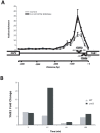A novel role for the transcription factor Cwt1p as a negative regulator of nitrosative stress in Candida albicans
- PMID: 22952822
- PMCID: PMC3430608
- DOI: 10.1371/journal.pone.0043956
A novel role for the transcription factor Cwt1p as a negative regulator of nitrosative stress in Candida albicans
Abstract
The ability of Candida albicans to survive in the presence of nitrosative stress during the initial contact with the host immune system is crucial for its ability to colonize mammalian hosts. Thus, this fungus must activate robust mechanisms to neutralize and repair nitrosative-induced damage. Until now, very little was known regarding the regulatory circuits associated with reactive nitrogen species detoxification in fungi. To gain insight into the transcriptional regulatory networks controlling nitrosative stress response (NRS) in C. albicans a compilation of transcriptional regulator-defective mutants were screened. This led to the identification of Cwt1p as a negative regulator of NSR. By combining genome-wide location and expression analyses, we have characterized the Cwt1p regulon and demonstrated that Cwt1p is directly required for proper repression of the flavohemoglobin Yhb1p, a key NO-detoxification enzyme. Furthermore, Cwt1p operates both by activating and repressing genes of specific functions solicited upon NSR. Additionally, we used Gene Set Enrichment Analysis to reinvestigate the C. albicans NSR-transcriptome and demonstrate a significant similarity with the transcriptional profiles of C. albicans interacting with phagocytic host-cells. In summary, we have characterized a novel negative regulator of NSR and bring new insights into the transcriptional regulatory network governing fungal NSR.
Conflict of interest statement
Figures






References
Publication types
MeSH terms
Substances
Grants and funding
LinkOut - more resources
Full Text Sources
Molecular Biology Databases

